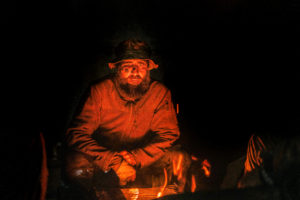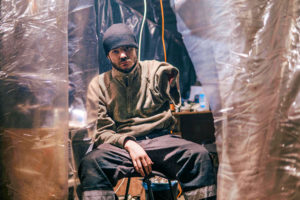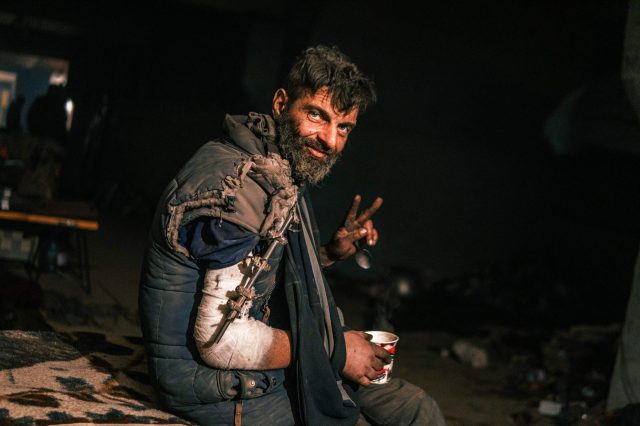
“People say that we are heroes,” says Lieutenant Illya Samoilenko. “But heroism only occurs when planning and organisation fails.” It’s early May and Samoilenko, second-in-command of the Azov Battalion that has spent weeks inside Mariupol’s besieged Azovstal steel plant, is talking to journalists in a closed press conference over Zoom. The steelworks are vast: a four-square-mile maze of tunnels designed to survive nuclear war. He is sitting against a filthy wall, clearly exhausted. His black hair is damp, his long beard has grown out under siege.
The situation is dire. There are around 2,000 soldiers in the plant, 700 of whom are reportedly wounded. But Samoilenko is defiant. “We could have retreated months ago when it was clear Russia was encircling us,” he says. “But we had to stay to fight.”
Ultimately, however, he is resigned: “We are military. Our job is to die for the country. I know that each one of our communications with the world can be our last. A lot of people in Ukraine gave their lives to defend the West. Don’t let it be in vain. We know that we’re dead men. That’s why we fight so fiercely.”
But in the weeks since that meeting, he received a reprieve — of sorts. Russia subsequently allowed wounded civilians to leave the plant. Then the soldiers started evacuating. Those inside were not just Azov fighters, but also Marines, police and border guards. On May 20, the last of them left in buses laid on by the Russian army. Ukraine and Russia had struck a deal to spare their lives. The Red Cross would accompany them out. The downside? They’d be going to Russian-controlled Donbas.
This is bad. The Azov Battalion are no ordinary fighters; they tied up Russian firepower for months, which gave other cities the chance to prepare and to better resist. In Ukraine, they call them the 300, or the Spartans: they are heroes. For Russia, though, they are something else entirely: the corporeal embodiment of the Nazi trope Moscow has used to justify its invasion of Ukraine from the very beginning.

“We’ve been accused of being Nazis and far-Right radicals and other bullshit,” Samoilenko told us. “The only thing we’re radical about is defending Ukraine.” But in the days since their capture, Russian officials have said that Azov fighters are “Nazi criminals” who must not be part of any prisoner swap with Ukraine. The battalion’s Twitter feed went silent on Friday. Ukrainian friends search for more information. They worry.
The story of the Azov fighters contains within it many of the contradictions and tropes and lies and truths that make up this war, while the story of their evacuation from the plant marks the end of the war’s beginning.
***
Russia has never got over its Second World War victory. It was perhaps its last unequivocal victory that was also an unequivocal moral good — even if the means were often anything but. It squats in the collective consciousness (helped by no end of state-sponsored content). Like so many national myths it is Manichean in form, based upon a fundamental binary: Good Russians versus Evil Nazis.
When Ayatollah Khomeini of Iran needed to send thousands of Iranians into Iraq to fight Saddam Hussein, he employed the imagery of the day of Ashura to motivate them. They were marching to fight not Saddam but the modern-day Caliph Yazid who had martyred Hussein at Karbala in 680, the central event of Shiism. As Khomeini was heard to have remarked: “Gradually the political dimension of this matter is becoming evident and, God willing, it will become even more apparent.”
Khomeini understood that to mobilise people to fight, you must give them the enemy they want. Moscow has been doing this since the moment Ukrainians overthrew their pro-Russian President, Viktor Yanukovych, in what Moscow described as a “fascist coup”. In those early days the Nazi enemy was Pravy Sektor, a hard-Right group that had battled government riot police and troops on the streets of Kyiv. Its leader Dmytro Yarosh became for Russians a kind of Emmanuel Goldstein figure, on to whom they could transpose all the sins of Nazi Ukraine. Wherever I went in the occupied east of the country in 2014, people told me tales of the murder and pillage he had apparently committed.

Pravy Sektor soon faded into irrelevance. Not least because a far more impressive — that is to say threatening — enemy had appeared: the Azov battalion. Founded in May 2014, it recaptured Mariupol from Russian forces (aligned with local pro-Russian separatists) in June. It was a big win for Ukraine. The Russians were enraged. It was, they said, a victory by Nazis.
They weren’t totally wrong. When Russia invaded Crimea in February 2014, and then eastern Ukraine in April, the Ukrainian state was in trouble. It was under attack and underprepared; it needed people who could fight — and fast. The requisite raw material could be found on the football terraces and among the far-Right. The movement had its origins in football Ultras in the North-eastern city of Kharkiv, who then morphed into a volunteer battalion originally called the “Black Corps” which some suggest was a reference to the official German Schutzstaffel (SS) periodical published in 1935-1944 (Das Schwarze Korps).
As Aris Roussinos has noted, the movement was founded in 2014 by Andriy Biletsky, former leader of the Ukrainian neo-Nazi group Patriot of Ukraine, during the Euromaidan Revolution. Biletsky was a typical far-Right scumbag, steeped in both thuggery and pseudo-intellectual, anti-Semitic thought. Among his more absurd and sinister claims was the one that Ukraine would “lead the white races of the world in a final crusade… against Semite-led untermenschen”.
But he didn’t last long. A career in politics — one that would ultimately fail — beckoned and off he went in late 2014. Meanwhile, as the analyst Ivan Gomza observes, the state knew it had to co-opt Azov and channel its militancy in a useful way, and so, in October 2014, it incorporated the battalion into Ukraine’s National Guard (a militarised branch of the Ministry of Internal Affairs). It has functioned under the auspices — and orders — of the state ever since.
Today, the battalion is a mix of political affiliations and ethnicities. The Jewish philosopher Bernard-Henri Lévy — one of the most public opponents of fascism and anti-Semitism in the world — recently spoke to several of its senior members. “There are so many different types of fighters,” he told me, “including Brits and Greeks and Jews and Georgians, and they are definitely not Nazis. This is just a slander.”
But it is a necessary one. Azov has proved to be Russia’s most formidable opponents. They held up the entire advance into south Ukraine. They came to embody everything Russia claimed it was fighting against. Now they are in its hands. How they are treated will provide a signpost to what comes next. If they appear at show trials — after obvious torture — then we will know that Putin is doubling down on his madness. If talks of a prisoner exchange materialise, it will signal that broader compromise is possible.
Either way, two things are clear. First, the Azov fighters are in the closest approximation to hell on earth for them right now. And second, their fate will decide what comes next, not just for them, but for the country for which they have fought so hard.










Join the discussion
Join like minded readers that support our journalism by becoming a paid subscriber
To join the discussion in the comments, become a paid subscriber.
Join like minded readers that support our journalism, read unlimited articles and enjoy other subscriber-only benefits.
Subscribe